The Samsung 750 EVO (120GB & 250GB) SSD Review: A Return To Planar NAND
by Billy Tallis on April 22, 2016 8:00 AM ESTRandom Read Performance
The random read test requests 4kB blocks and tests queue depths ranging from 1 to 32. The queue depth is doubled every three minutes, for a total test duration of 18 minutes. The test spans the entire drive, which is filled before the test starts. The primary score we report is an average of performances at queue depths 1, 2 and 4, as client usage typically consists mostly of low queue depth operations.

All the Samsung drives are crowding the top of the chart for low queue depth random read speeds, and the 750 EVO is way ahead of any other planar TLC drive here.
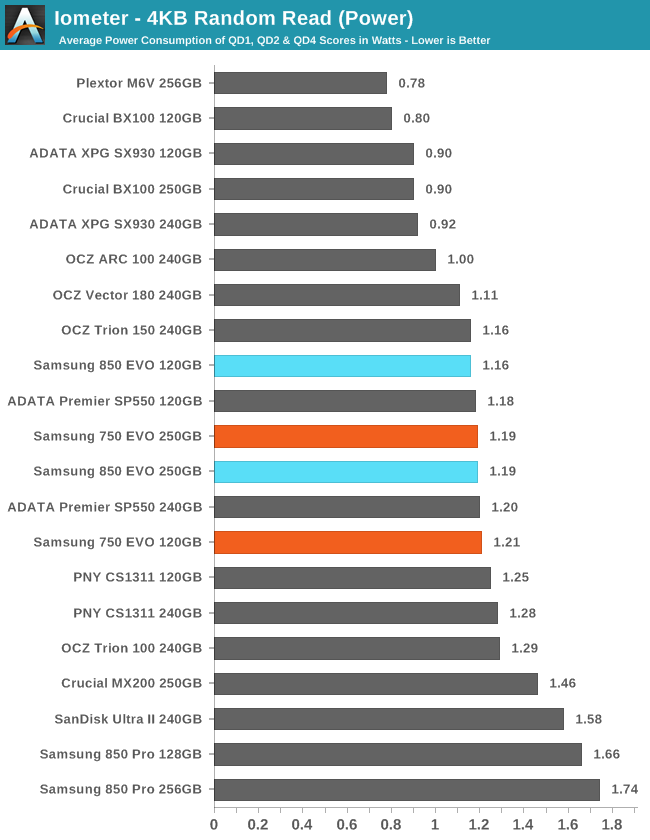
With power usage in the middle of the pack, the 750 EVO and 850 EVO are some of the most power-efficient drives on this test, but drives like the Plextor M6V are still at the top of the efficiency ranking.
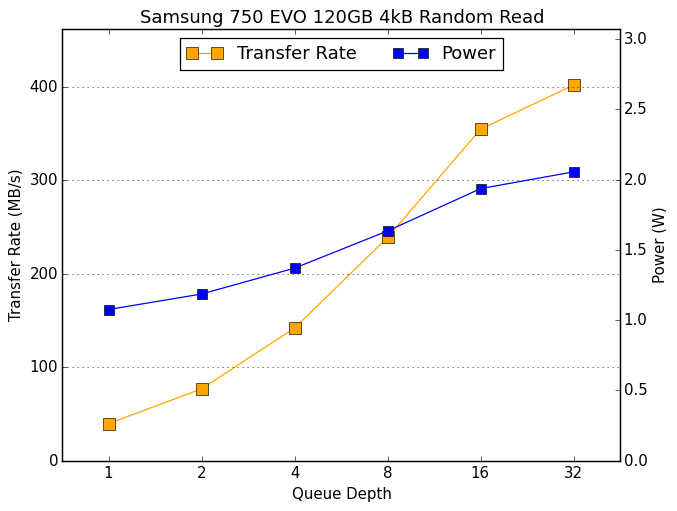 |
|||||||||
In addition to offering great performance at low queue depths, the 750 EVO scales up to reach higher speeds at QD32 than any non-Samsung drive, without power consumption getting out of hand.
Random Write Performance
The random write test writes 4kB blocks and tests queue depths ranging from 1 to 32. The queue depth is doubled every three minutes, for a total test duration of 18 minutes. The test is limited to a 16GB portion of the drive, and the drive is empty save for the 16GB test file. The primary score we report is an average of performances at queue depths 1, 2 and 4, as client usage typically consists mostly of low queue depth operations.
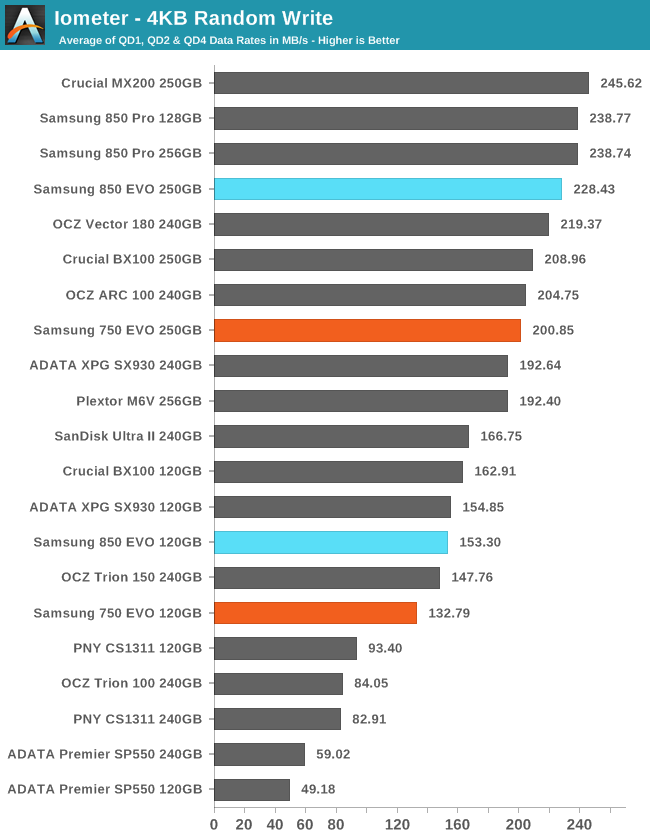
Taking capacity into account, the 750 EVO provides much better random write speeds than any other planar TLC drive, and the 250GB model is competitive against many MLC drives.
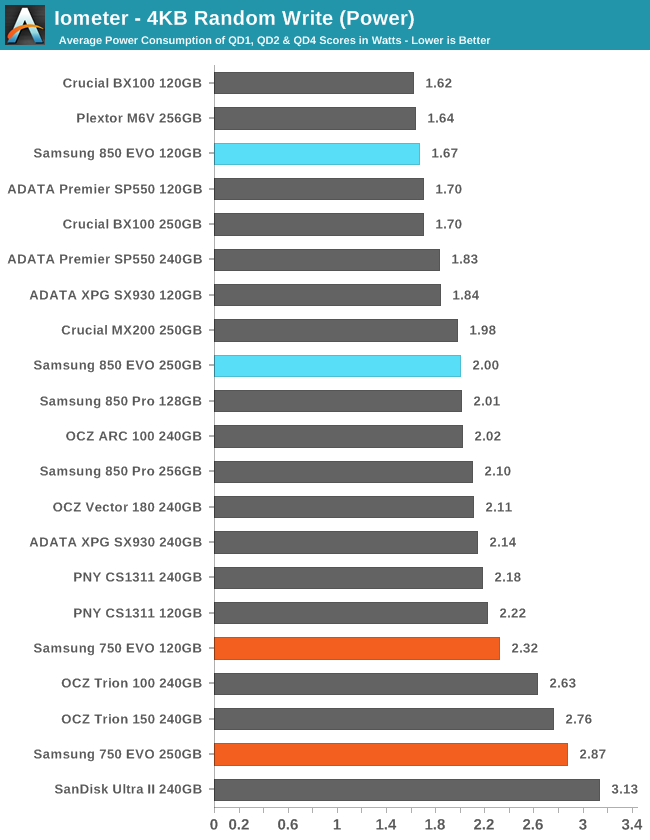
The 750 EVO is high-performing for a TLC drive but at the cost of requiring more power than most planar TLC drives and much more than the 850 EVO.
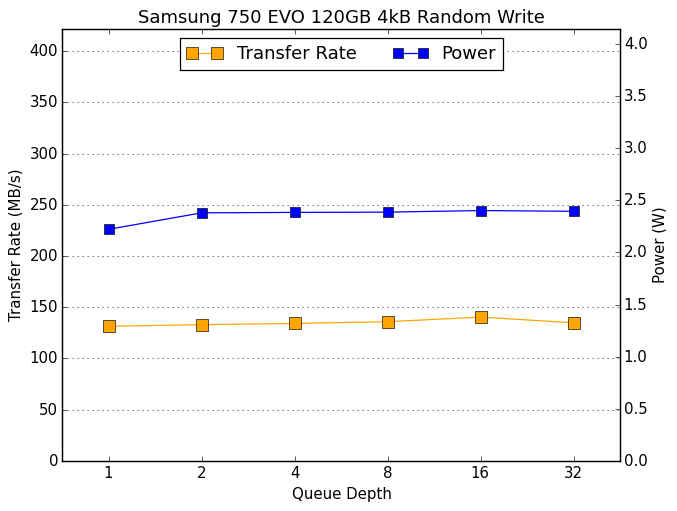 |
|||||||||
The 120GB 750 EVO shows almost no scaling with queue depth, while the 250GB needs a queue depth of at least two to reach full performance. By contrast, the 120GB 850 EVO shows a little bit of performance scaling from QD1 to QD2 and the 250GB 850 EVO doesn't hit full performance until QD4.










109 Comments
View All Comments
Coup27 - Friday, April 22, 2016 - link
SATA is not yesterdays tech.abrowne1993 - Friday, April 22, 2016 - link
More like yesteryearDeath666Angel - Friday, April 22, 2016 - link
So, everyone with perfectly capable CPUs that are barely slower than current tech should upgrade because SATA is old? I'm not disputing that SATA is the older tech, I'm just looking for a more nuanced and realistic view here. If your workload is sufficiently dependant on IO throughput, by all means get those NVMe drives. But implying that a SATA3 device like a 850pro is not going to do the job for a lot of people.... I have a Z87 4770k running at 4.5GHz. I'm not going to upgrade just for the convenience of M.2 PCIe NVMe support. And I won't do so until 6+ core CPUs with comparable IPC and OC abilities get decently priced.Meteor2 - Saturday, April 23, 2016 - link
No, not at all, and no-one said SATA is inadequate. But it is part of the past, just like 486s and dial-up modems.Bleakwise - Sunday, April 24, 2016 - link
No, SATA has a place. You realize a 2.5 SATA drive has about 10x-20x the volume of a NVME drive. No reason you could n't have a 3.5 inch SATA SSD either.Thus SATA will always be the go-to for high volume storage. Flash memory isn't going to be shrunk down anytime soon either, it degrades both performance and reliability, so until we get something better than flash SATA is going to be the only place you can get something like a 4TB or 8TB SSD.
Bleakwise - Sunday, April 24, 2016 - link
Shinking thing smaller and smaller is also more expensive, and like I said in terms of flash it also degrades performance. It's much cheaper to build a big-fast thing than a small-fast thing.There is also the issue of RAID and mechanical drives for mass storage. I can setup a 20TB fakeraid with an SSD write-back cache for under a thousand dollars. Hardware raid would be about 2000$. The NVME version would be about 8000$ to 10000$.
Billy Tallis - Sunday, April 24, 2016 - link
There are 2.5" NVMe drives using the U.2 connector to provide the same 4 lanes of PCIe that can be supplied by the M.2 connector.slowdemon21 - Friday, April 29, 2016 - link
Agree. SATA is the skylake bottleneckewitte - Tuesday, May 24, 2016 - link
I hacked my bios to run a 950 pro in a z87 it was ridiculous to spend so much upgrading from a 4790k.Coup27 - Friday, April 22, 2016 - link
Do you not think there is something wrong with the phrase "consumer grade NVMe 2TB+ SSD" ?You could also RAID some SATA 2TB SSD's to give you want you need. I doubt you "really" need all of that space on NVMe, so maybe a 256 or 512GB 950 Pro + some 850 EVO's in RAID would work well, and is available now.